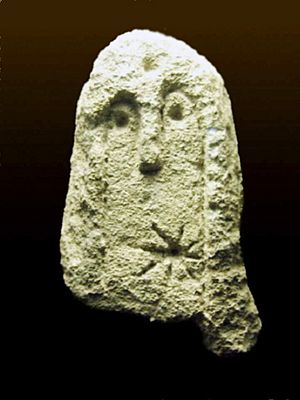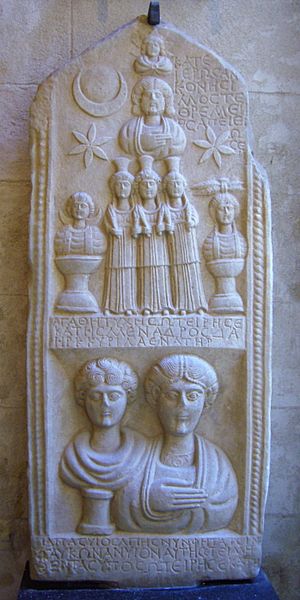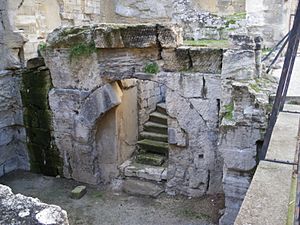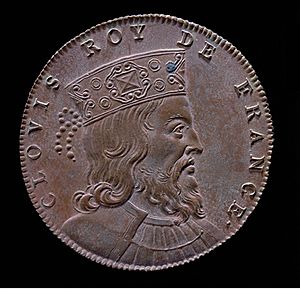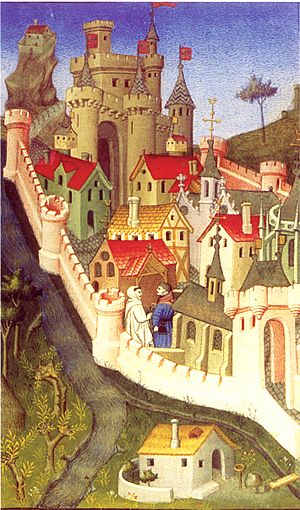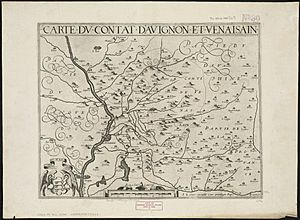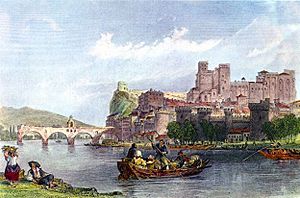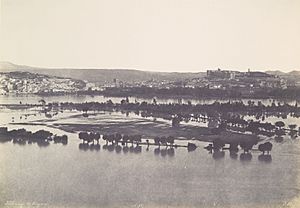History of Avignon facts for kids
Avignon, a historic city in southern France, has a long and exciting past! It's famous for its amazing Popes' Palace and the Avignon Bridge. For many years, Avignon was even the home of the Pope, making it a very important place in Europe. Let's explore its journey through time, from ancient settlements to a modern city.
Contents
Ancient Times in Avignon
People have lived in the area of Avignon for a very, very long time, even since the Stone Age! Digs on a hill called Rocher des Doms and in the Balance area show this.
In the 1960s, archaeologists found a small stone carving, about 20 cm tall, on the Rocher des Doms. It looked like a tombstone with a simple human face carved into it. It also had a unique sun symbol. This carving is from the time between the Copper Age and the Early Bronze Age. Other finds, like polished stone axes and pottery pieces, confirm that early people lived here.
Avignon's Roman Connections
The city's name, Avignon, first appeared around 600 BC. It might mean "city of violent wind" or, more likely, "lord of the river."
Around 539 BC, Greek traders from Marseille set up a trading post in Avignon. Later, in the 4th century BC, Marseille made alliances with cities in the Rhone valley, including Avignon.
When the powerful Roman legions arrived in 120 BC, Avignon became part of the Roman Empire. It was called Avennio. Not much from this Roman period remains today, just a few pieces of the old Roman market (forum) near Rue Molière.
In 121 and 122 AD, the Roman Emperor Hadrian visited Avignon. He gave Avignon the special status of a Roman colony, calling it "Colonia Julia Hadriana Avenniensis." This meant its citizens had Roman rights.
Around 290 AD, the first wooden bridge was built across the Rhone River, connecting Avignon to the other side. By the 3rd century, a small group of Christians lived outside the city walls.
Early Christianity in Avignon
We don't know exactly when Christianity first came to Avignon, but we know that Nectarius was the first official Bishop of Avignon in 439 AD. He attended important church meetings in the region.
Later, St. Agricol, who was a bishop between 650 and 700 AD, became the special patron saint of Avignon.
Avignon in the Middle Ages
Avignon faced many attacks during the early Middle Ages. In 472, the Burgundians attacked the city.
In 500 AD, Clovis I, the King of the Franks, attacked Avignon. He destroyed the fields and trees around the city. Avignon was saved by a Roman general.
In 536, Avignon became part of the Merovingian kingdom. Even with all the invasions, learning and culture continued to thrive in the city.
Saracen Attacks and New Kingdoms
In 734, Avignon was taken over by the Saracens (Muslims from North Africa and Spain). But in 737, the Franks, led by Charles Martel, destroyed the city because it had sided with the Saracens.
Later, in 879, Avignon became part of the new Kingdom of Provence. By 890, parts of the old bridge over the Rhone were fixed, making it possible to cross the river again.
In 932, the Kingdom of Provence joined with Upper Burgundy, forming the Kingdom of Burgundy. Avignon became one of its largest cities.
At the end of the 900s, Muslim groups from Spain set up a base nearby and raided the Alps. In 972, they captured a powerful abbot, demanding a huge ransom. This led to William I of Provence and his brother gathering nobles to drive the Saracens out of their hideouts in 973. William became the Count of Avignon.
By the year 1000, Avignon was starting to organize itself as a town. In 1032, Avignon became part of the Holy Roman Empire. The Rhone River became a border, with Avignon on the "Empire Land" side and the French king's land on the other.
Avignon's Independence and Sieges

After the Holy Roman Empire was divided, Avignon was owned by both the Count of Provence and the Count of Toulouse.
Avignon started to govern itself in 1129, creating its own local government called a "consulat."
In 1226, during a religious war called the Albigensian Crusade, Avignon declared itself an independent republic. The citizens refused to let King Louis VIII of France into the city. So, the king's army besieged Avignon for three months. Avignon was captured and forced to tear down its city walls and fill in its moats.
In 1249, Avignon again declared itself a republic. But in 1251, it had to submit to the French king's brothers, who became co-rulers of the city. Eventually, the city came under the rule of the King of Naples.
In 1303, Pope Boniface VIII founded the University of Avignon. It became famous for studying law and was very successful until the French Revolution.
The Popes in Avignon
From 1309 to 1377, Avignon became the home of the Pope instead of Rome! This period is known as the Avignon Papacy.
Pope Clement V chose Avignon as his home in 1309. His successor, Pope John XXII, made Avignon the capital of Christianity. He turned his old bishop's palace into the main Popes' Palace. Later popes, like Pope Benedict XII and Pope Clement VI, built the huge Old Palace and New Palace. In 1348, Pope Clement VI even bought the city of Avignon from the Queen of Naples for a large sum of money. Pope Innocent VI then built the city walls.
With the Popes living there, Avignon became a very busy and important city. Many merchants, artists, and musicians came to the city. The Popes' Palace, a magnificent Gothic building, was built by the best French architects and decorated by famous Italian painters.
The papal library in Avignon was the largest in Europe in the 14th century, with 2,000 books. Many scholars and artists, including those influenced by Petrarch, a founder of Humanism, gathered around the library. The Clementine Chapel attracted famous composers and musicians.
Popes Pope Urban V and Pope Gregory XI tried to move the Papacy back to Rome. Gregory XI finally succeeded in 1377, ending the first period of the Avignon Papacy.
However, after Gregory XI's death, a big split in the church called the Western Schism happened. Two "anti-popes," Antipope Clement VII and Antipope Benedict XIII, reigned again in Avignon.
The Popes built strong walls around Avignon, which are still well-preserved today. But they mostly relied on their incredibly strong palace, the Palais des Papes, which had walls 17-18 feet thick! This huge Gothic building was built between 1335 and 1364. After the French Revolution, it was used as a barracks and prison, but now it's a museum.
Avignon grew a lot during the time the Popes lived there. They built the impressive Popes' Palace and other important buildings like the churches of Saint-Didier, Saint-Pierre, and Saint Agricol. They also built fortifications around the city, stretching about 3 miles with 39 towers.
Merchants and bankers followed the Popes to Avignon, making it a center for trade. They brought goods from all over Europe, like grain, wine, fish, and rich fabrics. The university also attracted many students, who were often supported by the Popes.
Avignon in Recent Centuries
After the Popes returned to Rome, Avignon was governed by a papal representative called a Legate, or a Vice-legate.
French kings often wanted Avignon to be part of their kingdom. In 1476, King Louis XI of France sent troops to occupy the city. In 1536, King Francis I of France also invaded the papal territory. The people of Avignon welcomed him and were granted the same rights as French citizens.
In 1618, Cardinal Richelieu, a powerful French statesman, was exiled to Avignon.
French kings continued to try and take control of Avignon. King Louis XIV of France seized Avignon and the surrounding area twice in the 1600s, but returned them both times after agreements with the Pope. King Louis XV of France also occupied Avignon from 1768 to 1769.
In the early 1700s, Avignon's streets were narrow, but new buildings slowly replaced the old ones. The city was surrounded by farms and orchards. In 1733, a newspaper called the Courrier d'Avignon was founded. Since it was published in the papal territory, it could avoid some of the strict controls on newspapers in France.
From Revolution to Modern Times
During the French Revolution, in September 1791, the French government voted to make Avignon and the surrounding area part of France. This was confirmed in 1797 by a treaty.
In 1791, a terrible event known as the Massacres of La Glacière occurred. About 60 people were killed and thrown into a dungeon in the Popes' Palace.
In 1793, Avignon became the capital of the new French department of Vaucluse.
In 1822, the Archdiocese of Avignon was re-established, becoming an important church region again.
In 1847, the railway line connecting Avignon to Marseille was opened, improving travel and trade. The current Avignon Centre railway station was built in 1860. In 1898, electric trams started running in Avignon.
In 1856, a major flood of the Durance river caused damage in Avignon.
Avignon in the 20th and 21st Centuries
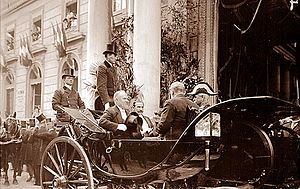
The 20th century saw Avignon grow a lot, especially outside its old city walls. The population almost doubled between 1920 and 1975.
In 1937, the Avignon - Caumont Airport was created, which later became an international airport.
In September 1947, the first Avignon Festival was held. This festival has grown to be a very famous arts and theater event.
After World War II, Avignon was honored for its bravery. The city worked hard to rebuild, expand its festival, restore its monuments, and develop tourism and trade.
In 1977, Avignon received the Europe Prize from the Council of Europe, recognizing its efforts for European unity.
In 1996, work began on the LGV Méditerranée high-speed railway. The Avignon TGV station was built between 1998 and 2001, connecting Avignon to other major cities by fast train.
In 2002, the Archdiocese of Avignon became part of the new church province of Marseille, but it kept its important rank.
In 2008, there was a small leak of unenriched uranium from a nuclear plant into two rivers near Avignon. Swimming and fishing were temporarily banned.
On July 2, 2017, a shooting occurred near a mosque in Avignon, injuring eight people. Authorities said it was not a hate crime or terrorist attack, and it seemed to target one person.
See also


